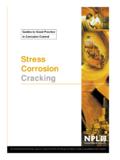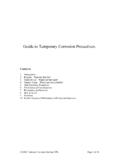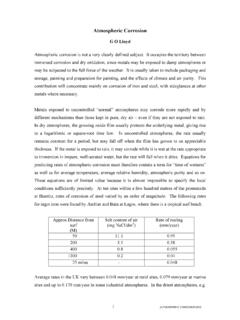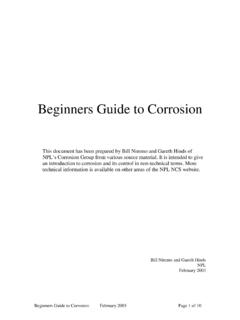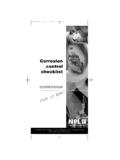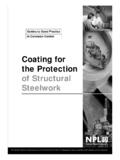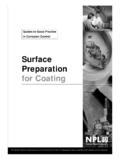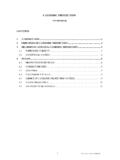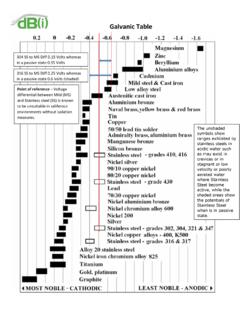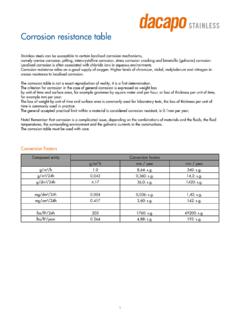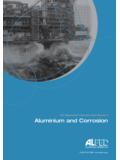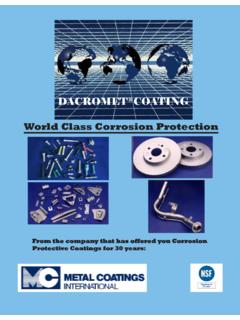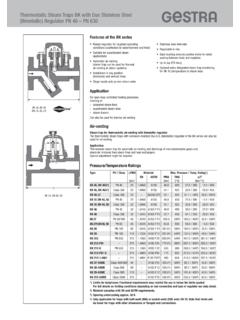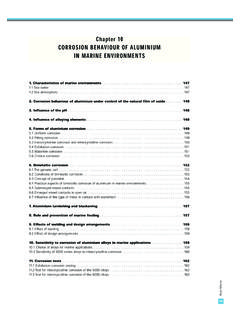Transcription of Bimetallic Corrosion - National Physical Laboratory
1 BimetallicCorrosionGuides to Good Practice in Corrosion ControlThe National Physical Laboratory is operated on behalf of the DTI by NPL Management Limited, a wholly owned subsidiary of Serco Group plcContents necessary for3bimetallic that effect3the rate of and flow condition 8and Corrosion 8without Physical Corrosion in some9common and embedded and and gas process of information15 BimetallicCorrosionThis is an update of a DTI publication first issued in 1982. The new versionhas been prepared by Dr. R. Francis of Weir Materials and Foundriesunder contract from NPL for the Department of Trade and purpose of this guide is to provide general informationabout Bimetallic Corrosion .
2 More detailed information can beobtained from British Standards Institution PublishedDocument PD6484: 1979 (1). Further advice on specificissues can be obtained from the organisations listed at theend of this a metal is immersed in a conducting liquid it takes upan electrode potential (also known as the Corrosion potential).This is determined by the equilibrium between the anodic andcathodic reactions occurring on the surface and it is usuallymeasured with reference to a standard electrode such as thesaturated calomel electrode (SCE). Bimetallic Corrosion occurs when two metals, with differentpotentials, are in electrical contact while immersed in an electrically conducting corrosive liquid, Because the metalshave different natural potentials in the liquid, a current will flowfrom the anode (more electronegative) metal to the cathode(more electropositive), which will incease the Corrosion on theanode, see Figure 1.
3 This additional Corrosion is Bimetallic Corrosion . It is alsoreferred to as a galvanic Corrosion , dissimilar metal corrosionor contact general, the reactions which occur are similar to those thatwould occur on single, uncoupled metal, but the rate of attack is increased, sometimes dramatically. With some metalcombinations the change in the electrode potential in thecouple potential can induce Corrosion which would not haveoccured in the uncoupled state ( pitting). In some environments the change in potential of the cathode in thecouple can also introduce problems ( hydrogen embrittlement).The effect of coupling the two metals together increases thecorrosion rate of the anode and reduces or even suppressescorrosion of the cathode.
4 Hence, coupling a component to a sacrificial anode can prevent Corrosion , and this is the principle of cathodic protection, which is discussed in a separate publication in this a metal is corroding two processes occur. One is thedissolution of metal at the anode ( iron):Fe Fe2++ 2eThis must be balanced by a cathodic reaction. Most practicalcases of Bimetallic Corrosion occur in solutions containing dissolved oxygen and in most neutral and alkaline liquids theprimary cathodic reaction is the reduction of dissolved oxygen:O2+ 2H2O + 4e 4 OHIn acid liquids the cathodic reaction is often the reduction ofhydrogen ions to hydrogen gas:2H++ 2e H2 Other Cathodic reactions can occur in deaerated environmentsand one example is liquids containing hydrogen is a range of partially oxidised sulphur species ( , dithionate etc.)
5 And reduction of one or more ofthese species can be the principle cathodic reaction in in sour process brines in the oil and gas uncoupled Corrosion the anodic and cathodic reactionsoccur at small, local areas on the metal. In a Bimetallic couplethe cathodic reaction is more, or totally, on the electropositivemember of the couple and the anodic reaction is mostly, ortotally, on the electronegative component of the this guide reference is made to a number of common alloysin general engineering use. For those unfamiliar with these,the alloys are listed in Table 1 by alloy group, common nameand nominal 1. Method of Bimetallic corrosiononeBimetallic CorrosionNOMINAL COMPOSITION (wt%)FeCCrNiMoNOthersAustenitic cast iron (flake)Balance2215--CuAustenitic cast iron (spheroidal)Balance2220--13/4 stainless stainless (Cu)22Cr (Cu, W)NAMENOMINAL COMPOSITION (wt%)CuNiZnAlFeSnOthersNaval Brass61-Balance--1 CZR BrassBalance-36---As, PbAluminium metal (LG2)Balance-5--5 PbGun metal (LG4)Balance-3--7 PbPhosphor bronzeBalance----5 PTin BronzeBalance----10 PNickel aluminium copper copper COMPOSITION (wt%)FeCrNiMoCuAlOthersAlloy 4002-65-Balance-Alloy 625321 Balance9--NbAlloy AlloysNickel AlloysTable 1.
6 Nominal composition of some common engineering alloysFerrous AlloysAluminium AlloysThere are too many to list individually but the main groups of alloys and the chief alloying additions are listed below:-1000 series - low alloy aluminium2000 series - Al-Cu3000 series - Al-Mn5000 series - Al-Mg6000 series - low alloy aluminium7000 series - Al-Cu8000 series - Al-MnBimetallic necessary for Bimetallic corrosionThe basic requirements necessary to cause Bimetallic Corrosion are:1An electrolyte bridging the two metals - which maynot always be aggressive to the individual metals when they are not coupled, and may be in the form of a bulk volume of solution, a condensed film, or a damp solid such as soil, salt deposits, or Corrosion connection between the metals.
7 This usually involves direct Physical contact but it can also arisewhere electrical continuity is established between two metals, for example, by an insulation-coated conductor, by structural metal work or electrical is not necessary for the metal junction to be immersed in the sufficient difference in potential between the two metals to provide a significant galvanic sustained cathodic reaction on the more noble of the two metals by one of the mechanisms described in the previous section; in most practical situations this is the consumption of dissolved that effect the rate of potentialThe electrode potential is determined by many factors but theonly fluid for which these factors are really well documentedis sea value of the potential for any alloy, even in sea water, canbe changed by a variety of factors such as temperature, velocity, biocide treatment etc.
8 However, the relative rankingof alloys remains largely unchanged by these factors. A simplified version of the galvanic series is shown in Table which are coupled to metals which have more electropositive potentials are the ones which may sufferbimetallic Corrosion . Stainless steels, such as 316, have athin, protective film and while this is intact Corrosion rates arevery low and the alloy is said to be in its passive state. Whenbreakdown of the film occurs, usually localised, such ascrevice Corrosion , then the stainless steel is said to be 2 shows that the potentials of low alloy stainless steels, such as 316, are very different in the active and passivestates. Although the ranking in Table 2 was derived for seawater, it is very similar for many other near neutral aeratedaqueous solutions, and thus may be used to assess the riskof Bimetallic Corrosion in these , the magnitude of the potential difference alone isnot sufficient to predict the risk of Bimetallic Corrosion .
9 Forinstance, metals with a potential difference of only 50 mVhave shown Bimetallic Corrosion problems, while other metalswith a potential difference of 800 mV have been successfullycoupled together. The potential differences between the metals provides no information on the kinetics of bimetalliccorrosion which depend upon the current flowing betweenthem. There is a wide range of factors which affect the severity of Bimetallic Corrosion such as area ratio, temperature,flow rate, composition of the electrolyte etc. The importantones are discussed general idea of the qualitative risk of Bimetallic corrosioncan be gained by putting these effects together into a formsuch as Figure 2.
10 This is not meant to be rigorous but gives aguide to acceptable and potentially dangerous 2 Simplified Galvanic Series in Sea WaterGraphitePlatinumGoldHigh Alloy Stainless Steels {Super Austenitic}{Super Duplex}TitaniumNickel Chrome{625; C-276}Molybdenum AlloysLow alloy stainless(PASSIVE)steels (eg 316)Alloy 400/Alloy K-500 SilverNickel Aluminium BronzeCopper nickel (70/30; 90/10)Gunmetals/Tin BronzesBrassesTinLeadAustenitic Cast IronLow alloy stainless(ACTIVE)steels (eg 316)Cast IronCarbon SteelAluminium alloysZincMagnesiumthreeBimetallic CorrosionElectroPositiveElectroNegativeF igure 2. Risk of additional Corrosion from Bimetallic contact in neutral aqueous electrolytes.[Each of the two metals must be read aginst the other. the degree of Corrosion always refers to the metal on axis A]Additional Corrosion unlikelyAdditional Corrosion may occurAdditional Corrosion possibleMagnesiumZincAluminium alloysCarbon SteelCast ironLeadTinAustenitic Cast IronBrassesGunmetals / Tin BronzesCopper Nickel AlloysNickel Aluminium BronzeAlloy 400/K-500 Low alloy stainless steelNickel-chrome moly alloysTitaniumHigh Alloy Stainless SteelGraphiteMagnesiumZincAluminium alloysCarbon SteelCast ironLeadTinAustenitic Cast IronBrassesGunmetals / Tin BronzesCopper Nickel AlloysNickel Aluminium BronzeAlloy 400/K-500 Low alloy stainless steelNickel-chrome moly alloysTitaniumHigh Alloy Stainless SteelGraphiteMetal inContactMetal beingconsidered (a)
